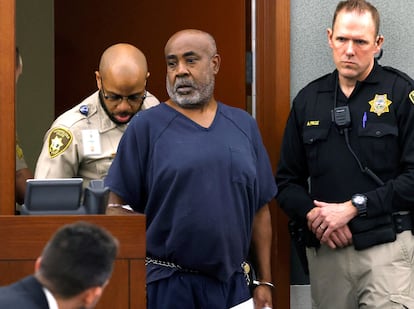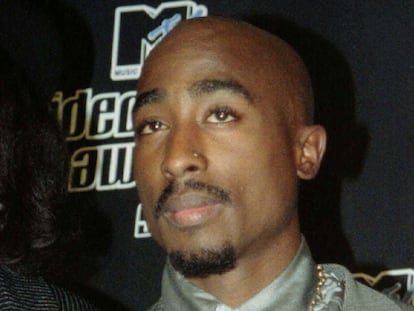Tupac Shakur: How one of rap’s biggest unsolved cases was broken almost 30 years later
The first arrest linked to the star’s murder, which occurred in 1996, exposes police omissions in the most violent years of the East-West hip-hop war


At first glance, there doesn’t appear to be anything special about the intersection of Flamingo and Kovac in Las Vegas. It is an area with very little pedestrian traffic about half a mile from the Strip, the most popular area of the gambling capital of the United States. Those who walk these corners are generally lost tourists or casino workers, accustomed to Sin City’s lesser-trodden back streets. A towering street light stands out in the urban landscape, covered in hundreds of inscriptions. These are farewell messages to Tupac Shakur, the rap legend who met his death in a drive-by shooting in 1996 on this nondescript stretch of road.
The site looks desolate today. “It’s not an official memorial or in good shape, but people made it,” says Isaiah, a security guard who watches over a construction site in front of the post. Its base is covered with cigarette butts and trash, but Isaiah says fans leave offerings there every September 13, the date the rapper died in a Las Vegas hospital, six days after he was shot from a white Cadillac while waiting at a stoplight. The memorial was desolate even in late September, days after the Las Vegas Metropolitan Police Department (LVMPD) made the first and only arrest of a suspect involved in the homicide of the hip-hop artist, nearly three decades after the crime.

Duane “Keefe D” Davis, 60, was arrested on the morning of September 29 in Henderson, a quiet neighborhood just off the chaotic Las Vegas Strip. Images released by the LVMPD show that the suspect did not put up any resistance. Davis, a former leader of the South Side Compton Crips street gang, was carrying only his phone and a bottle of water when he was arrested. Minutes later, as he waited inside a patrol car in front of the Metro Police building, an officer asked him why he had been stopped. “For the biggest case in Las Vegas history,” he allegedly replied.
Davis’ name was on the list of subjects of interest in the case for more than two decades. It took the arrival of a new sheriff, Kevin McMahill, for the investigation to start moving. The presumed resolution of one of rap’s most famous mysteries was also tied to a publishing development: Davis’s 2019 memoir, Compton Street Legend, in which he sought to raise his profile as a street soldier for Los Angeles gangs and their role in the rise of the Death Row Records and the East-West clash that claimed the lives of the Notorious B.I.G. and Tupac. The book proved instrumental in the police reviewing the case.
Davis, the youngest of 12 children, describes in the book how his family settled in Compton in the mid-1960s by buying a house after his father had a lucky break in a Tijuana casino. Among his childhood friends was Marion “Suge” Knight, who would later become the founder of Death Row Records and whose name would be tied to that of Davis over the events of September 1996. Davis became involved with the Crips in 1971, in a neighborhood that also produced rappers including Eazy E, Dr. Dre, and Coolio. Drug dealing landed Davis in prison in the mid-1980s, where he became hardened as a criminal, he recounts.
Davis claims to have been the co-driver of the white Cadillac from which the bullets that fatally wounded Tupac were fired. On the night of September 7, 1996, tension in Las Vegas was at its peak. The city, the boxing capital of the world, was full of gang members who had come to see Mike Tyson fight. He knocked out Bruce Seldon in the first round and the spectators were left wanting more. In the lobby of the MGM Grand Las Vegas there was a fight involving Suge Knight and his companions, who were associated with the Mob Piru Bloods, fierce rivals of the Crips. Orlando “Baby Lane” Anderson, Davis’ nephew, was severely beaten, leading Keefe D and his crew to vow revenge.
The streets of Las Vegas provided them with a chance two and a half hours later at a red light. Davis, Anderson, Terrence “Bubble Up” Brown and DeAndre “Big Dre” Smith, all in the Cadillac, ran into Tupac and Suge Knight’s black BMW. “The next few seconds went by very quickly,” Davis writes. “Tupac made an erratic movement and began to reach down beneath his seat [...] and that’s when the fireworks started. One of my guys from the back grabbed the Glock and started bustin’ back.” Shakur was hit twice in the chest and died a week later.

Police omissions
The homicide sent shockwaves throughout the West Coast, one of the most important centers of gangster rap. The Compton Police Department received calls days later from informants claiming to have seen Orlando Anderson on the streets with a semi-automatic Glock, the same model as the murder weapon. The crime triggered 10 days of violence in Compton, where retaliation between Crips and Bloods left three dead and a dozen wounded.
A group of Compton detectives tasked with combating gangs reported the findings to the LVMPD. “We told Vegas right then we thought the Southside Crips were responsible for the murder and that Orlando was the shooter,” one of those detectives, Bobby Ladd, told the Los Angeles Times in 2002. Nevada agents failed to act on the information, which led to frustration among the California investigators.
The Compton officers were well aware of the difficulty of investigating crimes committed by gang members. The laws of the street demand a code of silence. The Las Vegas investigation, however, was criticized because those leading it had refused to follow the most obvious lines. One of these was the fight at the MGM Grand. “Investigators have no reason to believe that the altercation has any connection to the shooting,” Homicide Commander Kevin Manning said in 1996.
It was the California investigators who confirmed, after reviewing security camera footage from the casino, that the man Knight’s entourage had beaten was Orlando Anderson. The footage showed that he had a brief exchange of words with Tupac. Las Vegas officers did not ask for video footage to follow Anderson’s tracks along the Strip after the beating, despite it being an area with numerous surveillance devices. The footage from that night was deleted seven days later. Nor did officers trace the white Cadillac, which had been rented.
Anderson died in 1998 in a shootout in Compton. During his lifetime, he had always denied being the shooter. The other passengers in the car that night are also deceased: Big Dre died in 2004 and Bubble Up, who was driving the Cadillac, was killed in a shooting in Compton in 2015. Davis is the sole survivor and his memories of that night could end his days at large if he is found guilty of Tupac’s murder. “There is only one thing certain in the life of the gangster,” he wrote in his book. “You know that what you have done will come for you; you don’t know when, but there is no doubt in your mind that it will come back.”
Suge Knight: " Orlando wasn’t the shooter"
Suge Knight was another witness to the events of September 7, 1996. The Death Row Records founder has been in prison since 2018, serving a 28-year sentence on a voluntary manslaughter charge unrelated to the death of Tupac Shakur. From jail, the businessman and self-proclaimed mobster told TMZ that he was surprised by Davis' arrest.
“I can tell you this: I never had nothing bad to say about Orlando because he wasn’t the shooter. It wasn’t Anderson, so that’s all I got to say about that part,” Knight said. Anderson testified on his behalf during his 2018 trial.
Knight has said he is not interested in testifying in the Davis trial. His lack of cooperation with authorities is not new. He has said publicly since 1996 that he will never tell police who the killer was. “I’m not gonna get on the stand and testify on somebody. For what?”
Sign up for our weekly newsletter to get more English-language news coverage from EL PAÍS USA Edition
Tu suscripción se está usando en otro dispositivo
¿Quieres añadir otro usuario a tu suscripción?
Si continúas leyendo en este dispositivo, no se podrá leer en el otro.
FlechaTu suscripción se está usando en otro dispositivo y solo puedes acceder a EL PAÍS desde un dispositivo a la vez.
Si quieres compartir tu cuenta, cambia tu suscripción a la modalidad Premium, así podrás añadir otro usuario. Cada uno accederá con su propia cuenta de email, lo que os permitirá personalizar vuestra experiencia en EL PAÍS.
¿Tienes una suscripción de empresa? Accede aquí para contratar más cuentas.
En el caso de no saber quién está usando tu cuenta, te recomendamos cambiar tu contraseña aquí.
Si decides continuar compartiendo tu cuenta, este mensaje se mostrará en tu dispositivo y en el de la otra persona que está usando tu cuenta de forma indefinida, afectando a tu experiencia de lectura. Puedes consultar aquí los términos y condiciones de la suscripción digital.
More information
Archived In
Últimas noticias
The metaverse, four years later: Is it finished or just at a standstill?
$3,000 and a plane ticket: The United States increases incentives for migrants to self-deport before the end of the year
Charles Dubouloz, mountaineering star, retires at 36 with a farewell tour inspired by Walter Bonatti
From the White House to diplomatic gifts: Lego wins over adult fans, brick by brick
Most viewed
- The low-cost creative revolution: How technology is making art accessible to everyone
- Christian Louboutin: ‘Young people don’t want to be like their parents. And if their parents wear sneakers, they’re going to look for something else’
- All the effects of gentrification in one corner of Mexico’s Colonia Roma
- Christmas loses its festive spirit: ICE fears cast shadow over religious celebrations
- Liset Menéndez de la Prida, neuroscientist: ‘It’s not normal to constantly seek pleasure; it’s important to be bored, to be calm’










































